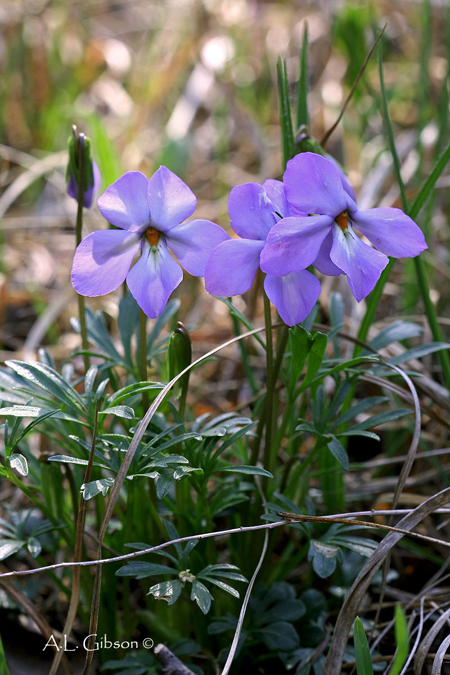Viola pedata L. var. pedata
Common names:
Bird's-foot Violet, Crow's-foot Violet
Synonyms:
Viola pedata L. var. pedata, Sp. pl., ed. 1, 2: 933. 1753. TYPE: "Habitat in Virginia." Type: USA, Virginia, [no date], [Kalm s.n.] (lectotype designated by Reveal & al., Huntia 7: 238. 1987: Herb. Linn. No. 1052.2 (LINN-HL1052-2), Global Plants Database image!).
Viola pedata L. f. lineariloba (Ging.) F.Seym., Fl. New England, ed. 2: 602. 1982; Viola pedata L. var. lineariloba DC., in DC., Prodr. 1: 291. 1824
Viola pedata L. var. lineariloba DC. f. alba (Thurb.) House, Bull. New York State Mus. Nat. Hist. 243-244: 46. 1923 ["1921"]; Viola pedata L. f. alba (Thurb.) Britton, Bull. Torrey Bot. Club 17: 124. 1890; Viola pedata L. var. alba Thurb., Bull. Torrey Bot. Club 1(5): 20. 1870
Viola pedata L. var. lineariloba DC. f. rosea (A. L. Sanders) House, Bull. New York State Mus. Nat. Hist. 243-244: 56. 1923 ["1921"]; Viola pedata L. f. rosea A. L. Sanders, Rhodora 13: 172. 1911
Viola inornata (Greene) Greene, Leafl. bot. observ. 1(1): 2. 1903-1906; Viola pedata L. var. inornata Greene, Pittonia 3: 35. 1896
Viola ampliata Greene, Leafl. bot. observ. 1(1): 3. 1903-1906
Viola pedata L. f. bicolor Pursh ex Britton, Bull. Torrey Bot. Club 17: 123. 1890
Viola pedata L. var. atropurpurea DC., in DC., Prodr. 1: 291. 1824
Viola pedata L. var. velutina Schwein., Amer. J. Sci. 5: 51. 1822
Viola digitata Pursh, Fl. Amer. sept. 1: 171. 1813
Viola multifida Mill., Gard. Dict., ed. 8: n. 5. 1768
Description:
Largest leaf blades deeply pedately divided into usually 7–11 linear-oblanceolate lobes, 1 lobe in the terminal primary division and 3–5 in each lateral primary division, outline broadly ovate to reniform, base typically truncate to cordate, margins entire or with 1–2 subapical crenations or teeth on either side, apex broadly rounded, or rarely leaf blades obrhombic or obovate in outline and shallowly to moderately lobed due to partial fusion of leaf segments (see comments regarding "ranunculifolia" phenotype under V. pedata). Other features are identical to the species.
Ecology:
Same as the species.
Distribution:
Same as the species.
Rarity:
None.
Phenology:
Presumably same as the species.
Affinities:
Same as the species.
Hybrids:
None confirmed.
Comments:
The bicolorous floral morph of var. pedata in particular has been lauded as “the queen of violets”, and it is certainly one of the more stunning violets of our region. Even extracting the two varieties expressing the most extreme examples of leaf blade dissection (var. cuneatiloba and var. flabellata, the remaining “typical” variety still embraces considerable leaf blade variation, including both developmental variation within individuals through the growing season and among individuals within populations. The present taxon is easily distinguished in chasmogamous flower from V. pedatifida, but fruiting specimens are often confused in their broad zone of overlap in the Midwest. The strictly pedately divided leaf blades of var. pedata are diagnostic, and the short vertical barrel-like rhizome, long-adnate stipules and lack of cleistogamous reproduction further separate it. V. pedata as a whole inhabits far more xeric, sandy or gravelly acidic soils than is typical for V. pedatifida.
Literature Cited:
Little, R. J., and L. E. McKinney. 2015. Violaceae. In Flora of North America: Cucurbitaceae to Droseraceae, 106. Oxford University Press, New York, NY.McKinney, L. E., and N. H. Russell. 2002. Violaceae of the southeastern United States. Castanea 67: 369-379.
Russell, N. H., and W. Bowen. 1960. A hypothesis to account for unusual leaf variation in Viola pedata L. Proceedings of the Iowa Academy of Science 67: 189-194.

Chasmogamous flowering habit by Andrew Gibson, "Buckeye Botanist" website

Chasmogamous flower (bicolorous floral morph) front view by Arthur Haines, Native Plant Trust

Chasmogamous flower (concolorous floral morph) front view by Arthur Haines, Native Plant Trust